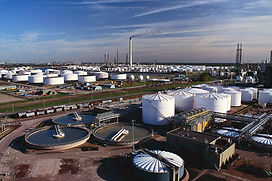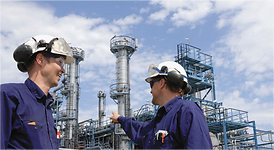
Özlem Academy Education Consultancy Inc.
CONTACT US FOR YOUR QUESTIONS
Address : Tatlısu Mah. Pakdil Sok. PERSPECTIVE Plaza No:5 Floor:1 Flat:3, Şerifali Cd., 34774 Umraniye/Istanbul
Tel Office: +90 (216) 594 55 25
Mobile: +90 (533) 380 83 72

Our services
SAFETY INTEGRITY LEVEL
(SIL)
VALIDATION AND VERIFICATION SERVICE
We offer the highest quality Safety Integrity Level (SIL) Validation and Verification service within the scope of Major Accident Scenario Document with our Class A Occupational Safety Expert and Class C Occupational Safety Expert staff.
You can entrust your "Quantitative Risk Assessment" studies within the scope of Seveso Directive to us!
“Regulation on Preventing Major Industrial Accidents and Reducing Their Effects” A major accident scenario document is prepared or made to be prepared by the operator of the lower and higher level establishments in order to determine the major industrial accident hazards and to evaluate the risks arising from these hazards.
in regulation Major Accident Scenario Document; It is defined as the document prepared in order to determine the major industrial accident hazards in the organization and to evaluate the risks that may arise from these hazards.

SAFETY INTEGRITY LEVEL
( SIL)
VALIDATION AND VERIFICATION SERVICE
Let's Do Your Quantitative Risk Assessment Studies Together!
What is a Security Instrumented System (SIS)?
A Safety Instrumented System is designed to prevent or reduce hazardous events by placing a process in a safe state when predetermined conditions are violated. Other common terms used are safety interlocking systems, emergency shutdown systems, and safety shutdown systems (ESD).
Every SIS has one or more Security Instrumented Functions (SIF). A SIF loop has a combination of logic decoder(s), sensor(s), and end element(s) to perform its function. Each SIF within a SIS will have a SIL level. These SIL levels may be the same or different depending on the process. It is a common misconception that the entire system must have the same SIL level for every safety function.
What is Safety Integrity Level (SIL)?
Safety integrity level (SIL) is a measure of the likelihood that a safety system or safety function will fail to perform its intended safety function. The higher the SIL level, the less likely it is that the safety system or safety function will fail.
The SIL level is typically expressed on a scale of 1 to 4; SIL 1 is the lowest level and SIL 4 is the highest level. Each SIL level is associated with a specific target safety level, expressed as the probability of a hazardous malfunction occurring.
The target safety level is expressed in terms of the probability of failure on demand (PFD), which is the probability that the safety function will fail when needed. The lower the PFD, the higher the level of security provided by the security system or security function.
As the IL level increases, the installation and maintenance costs and complexity of the system generally increase. Particularly for process industries, SIL 4 systems are so complex and costly that their implementation is economically expensive and difficult. Additionally, if a process involves so many risks that a SIL 4 system is required to return it to a safe state, then it may also indicate that there is a fundamental problem in the process design that needs to be addressed by a process change or other production methods.
Why Should Safety Integrity Level (SIL) Be Validated and Verified?
It is a very common misconception that Electronic/Electrical and Programmable products or components have a SIL rating. Rather, products and components are suitable for use in a particular SIL environment but are not individually SIL rated.
SIL levels apply to safety functions and safety systems (SIFs and SISs). Logic solvers, sensors and end elements are only suitable for use in certain SIL environments and can only ensure correct implementation of the safety system by verifying and ensuring the reliability of this function by expert engineers.
To calculate the safety integrity level (SIL) required for a safety function, several factors need to be taken into account, including the severity of the consequences of a failure, the likelihood of the safety function failing, and the frequency of exposure to the hazard.
Additionally, calculating the SIL required for the safety function typically involves the following steps:
-
Hazard Analysis: A hazard analysis is performed to identify hazards associated with the equipment or system and determine the likelihood and consequences of each hazard. The results of the hazard analysis are used to identify the safety functions required to reduce or prevent each hazard.
-
Risk Assessment: A risk assessment is conducted to evaluate the effectiveness of each safety function in reducing the risk associated with each hazard. Risk assessment takes into account the probability of failure of the safety function, the severity of the consequences of the failure and the frequency of exposure to the hazard. The results of the risk assessment are used to determine the required SIL for each safety function.
-
SIL Calculation: The SIL required for each safety function is calculated based on the results of the risk assessment. The SIL calculation takes into account the probability of failure of the safety function and the target safety level expressed in terms of the probability of a dangerous failure occurring.
-
Validation and Verification Calculation: To successfully achieve the desired level of risk reduction, the equipment or system must be used as intended. Purchasing components that comply only with SIL 2 or SIL 3 does not guarantee a SIL 2 or SIL 3 system. For this reason, the Safety Instrumented Function must be validated and verified for the equipment used as a system. Calculating the probability of failure of a safety function typically involves using failure rate data for components of the safety function. Failure rate data is used to calculate the probability of failure of a safety function over a given period.
Major Accident Scenario Document Communiqué According to the Regulation on Preventing Major Industrial Accidents and Reducing Their Effects
Obligations:
The operator of a lower or higher level organization prepares or has a major accident scenario document prepared by complying with the specified format and general rules and fulfilling the minimum requirements. The major accident scenario document is not sent to the Ministry of Family, Labor and Social Services, but is kept in the organization.
NOTIFICATION OF MAJOR ACCIDENT SCENARIO DOCUMENT TO BE PREPARED REGARDING MAJOR INDUSTRIAL ACCIDENTS
Annex-1 FORMAT AND GENERAL RULES OF MAJOR ACCIDENT SCENARIO DOCUMENT
8.4. Principle of independence and effectiveness
In calculating the frequency of occurrence of scenarios, the principle of independence, the effect of common cause errors and the principle of effectiveness are also taken into account.
MINIMUM REQUIREMENTS FOR MAJOR ACCIDENT SCENARIO DOCUMENT:
-
Major accident scenario document team: A team should be formed to prepare the scenario document.
-
Steps for preparing scenarios: Steps such as identification and classification of hazardous substances, identification of hazardous equipment, identification of internal hazards, identification of external hazards, creation, analysis and evaluation of major accident scenarios are followed.
-
Identification and classification of hazardous substances: Hazardous substances are identified and classified. The SEA Regulation is taken as basis.
-
Identification of hazardous equipment: Hazardous equipment is identified and listed.
-
Identification of internal hazards: Internal hazards related to hazardous equipment are identified.
-
Identification of external hazards: External hazards in the organization's environment are identified.
-
Creation, analysis and evaluation of major accident scenarios: Scenarios are created, frequencies are calculated, compared with limit values and necessary measures are decided.
-
Other issues: Other important issues such as critical equipment, frequency calculation methods, operator errors, independence and efficiency principles are stated.
The steps to be followed to prepare the major accident scenario document are explained in detail below:
Step 1: Identification and Classification of Hazardous Substances
Step 2: Identifying Hazardous Equipment
Step 3: Identifying Internal Hazards
Step 4: Identifying External Hazards
Step 5: Creation, Analysis and Evaluation of Major Accident Scenarios
This document specifies how the major accident scenario document should be prepared in accordance with the requirements of the "Regulation on the Prevention of Major Industrial Accidents and Reducing Their Effects" and the limit value of the major industrial accident frequency.
Limit Value of Major Industrial Accident Frequency:
For hazardous equipment that may cause major accidents, the operator reduces the frequency of occurrence of each major industrial accident scenario to 1x10-4/year or less.
This document explains how an enterprise should prepare its major accident scenario document in accordance with these regulations and what kind of values are targeted in order to prevent major industrial accidents and reduce their effects.
To get a detailed idea about Quantitative Risk Assessment and GMS, please review the Article and Blog section.

Employer's Obligation to Take Action
Regulation on Preventing Major Industrial Accidents and Reducing Their Effects
Article 6:
General Obligation of the Operator
The operator is obliged to take all necessary measures to prevent major accidents and, in cases where it cannot be prevented, to limit their effects in a way that causes the least damage to the environment and people.









